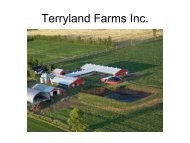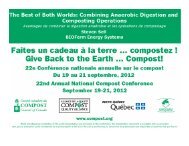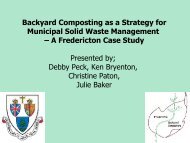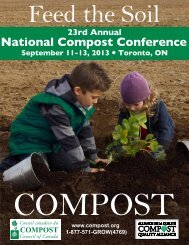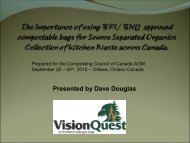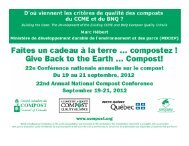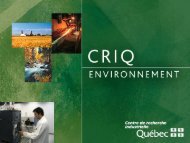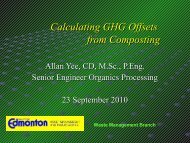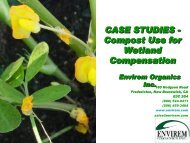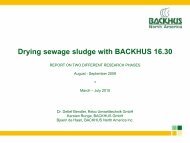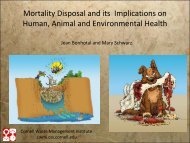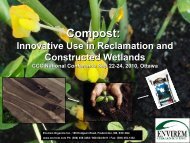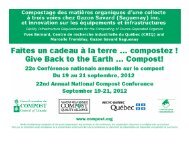Compostable Plastics versus Paper and Polyethylene – Life Cycle ...
Compostable Plastics versus Paper and Polyethylene – Life Cycle ...
Compostable Plastics versus Paper and Polyethylene – Life Cycle ...
Create successful ePaper yourself
Turn your PDF publications into a flip-book with our unique Google optimized e-Paper software.
<strong>Compostable</strong> <strong>Plastics</strong> <strong>versus</strong> <strong>Paper</strong> <strong>and</strong><br />
<strong>Polyethylene</strong> <strong>–</strong> <strong>Life</strong> <strong>Cycle</strong> Analysis<br />
Robert Armstrong<br />
Market Development Manager<br />
BASF Canada<br />
September 2006
BASF Vision 2015<br />
Ensure Sustainable Development<br />
We combine economic success with environmental<br />
protection <strong>and</strong> social responsibility<br />
We see sustainability as a long-term competitive advantage<br />
We use our eco-efficiency <strong>and</strong> total cost of ownership tools<br />
to identify the best economical <strong>and</strong> ecological solutions<br />
We create value for our customers
The three “pillars” of sustainable<br />
development<br />
Ecology<br />
EEA<br />
Economy<br />
TCO<br />
Society<br />
SEE<br />
EEA = Eco-efficiency analysis<br />
TCO= Total Cost of Ownership<br />
SEE = Socio-eco-efficiency Analysis (SEEbalance)
Bio Terms Definition<br />
Feedstocks<br />
Biobased <strong>–</strong> Referring to the origin of the feedstocks of a product -<br />
needs a percentage designation to be meaningful.<br />
Renewable <strong>–</strong> Referring to the feedstocks being renewed in a certain<br />
time frame (ex. Corn, wheat, bacteria, grass).<br />
Sustainable <strong>–</strong> Generic term used to express the long term viability of a product,<br />
process or market.<br />
These terms are not equivalent<br />
Disposal<br />
Degradable <strong>–</strong> Process of fragmentation.<br />
Biodegradable <strong>–</strong> Process of organic matter being consumed by<br />
microorganisms <strong>and</strong> converted to energy <strong>and</strong> waste products.<br />
<strong>Compostable</strong> <strong>–</strong> Specific biodegradable disposal in which moisture, oxygen <strong>and</strong><br />
heat content are professionally managed. Organic matter<br />
biodegrades swiftly <strong>–</strong> in 180 days or less.
Biodegradability<br />
In order for a material to be viewed as biodegradable or compostable,<br />
it must meet established st<strong>and</strong>ard specifications.<br />
EN 13432 GreenPla ASTM D-6400<br />
Without certification programs, the credibility of biodegradable plastics<br />
remains at risk, <strong>and</strong> thus growth in use is also at risk.<br />
Why make Biodegradable polymers?
Waste Generation <strong>and</strong> Recycling 2003 - EPA<br />
Organics/<strong>Compostable</strong>s<br />
= 40 - 65 %
Ecoflex ® Description<br />
Ecoflex is a Copolyester polymer which is<br />
fully biodegradable under composting conditions <strong>and</strong> in soil.<br />
Ecoflex is processed on conventional blown film, cast film <strong>and</strong><br />
extrusion coating equipment designed for traditional polyolefins.<br />
Ecoflex exhibits physical properties similar to low density<br />
polyethylene as a thin film.<br />
Compost<br />
4 weeks<br />
No predrying of Ecoflex is required.<br />
2 weeks<br />
Ecoflex has no biobased content.
<strong>Compostable</strong> Can<br />
Liners<br />
Lawn <strong>and</strong> Leaf Bags<br />
T-shirt bags<br />
Food Packaging
Ecoflex <strong>and</strong> Renewables<br />
Ecoflex ®<br />
Starch<br />
Natural<br />
Fibers<br />
PLA<br />
flexible,<br />
soft, tough<br />
films, flexible<br />
packaging, paper coating<br />
semiflexible,<br />
impact resistant<br />
flexible packaging,<br />
molding, forming, bags<br />
rigid,<br />
low cost<br />
rigid packaging,<br />
loose fill, molding<br />
Blends
Ecoflex ® <strong>and</strong> Renewables<br />
Ecoflex ®<br />
PLA<br />
flexible,<br />
soft, tough<br />
films, flexible<br />
packaging, paper coating<br />
semiflexible,<br />
impact resistant<br />
flexible packaging,<br />
molding, forming, bags<br />
rigid,<br />
lower cost<br />
rigid packaging,<br />
molding<br />
New Compounding Technology
Polymer Performance<br />
Comparison of Polymers<br />
4.00<br />
Modulus (MPa)<br />
3.50<br />
3.00<br />
2.50<br />
2.00<br />
1.50<br />
1.00<br />
0.50<br />
0.00<br />
PHB PLA<br />
PS<br />
PET<br />
PP<br />
Ecovio ®<br />
Starch<br />
PBS<br />
LDPE<br />
0 200 400 600 800 1000<br />
Elong. at Break (%)<br />
HDPE<br />
PCL Ecoflex ®<br />
St<strong>and</strong>ard Plastic<br />
Biodegradable Plastic
Eco-efficiency Analysis<br />
BASF strategic tool to help drive towards <strong>and</strong> measure<br />
sustainability<br />
Developed in Germany in 1996<br />
Over 260 projects completed globally<br />
Third-party certified by the German<br />
Technical Monitoring Association (TŰV)<br />
Validated<br />
Ecoefficiency<br />
Analysis<br />
Method
Considers the <strong>Life</strong> <strong>Cycle</strong><br />
Extraction of<br />
Raw Materials<br />
Processes<br />
Products<br />
Recycling<br />
Use of products<br />
Disposal
Eco-Efficiency<br />
The Ecological Component<br />
Eco-efficiency analysis looks at the entire life cycle of a product,<br />
beginning with extraction of raw materials through the disposal or<br />
recycling of the product. An "ecological fingerprint," provides a picture of<br />
the environmental effect of a product in six categories:<br />
• Materials consumption<br />
• Energy consumption<br />
• Emissions to air, soil, <strong>and</strong> water<br />
• Risk potential<br />
• Toxicity potential<br />
• L<strong>and</strong> use<br />
Each of these categories embraces a<br />
wealth of detailed information, some of<br />
which comes from BASF’s in-house<br />
records <strong>and</strong> some from public databases (Boustead database).
Development of Ecological Impacts<br />
Parameters considered<br />
Ecological fingerprint<br />
Adverse Ecological<br />
•Raw Materials<br />
•Energy consumption<br />
L<strong>and</strong> Use<br />
Energy Consumption<br />
1.00<br />
Emissions<br />
0.50<br />
Relative environmental<br />
impact<br />
High<br />
Product 2<br />
•L<strong>and</strong> Use<br />
0.00<br />
•Emissions<br />
•Toxicity<br />
Raw Materials<br />
Risk Potential<br />
Toxicity Potential<br />
BASF<br />
Product 1<br />
•Risk potential<br />
Low<br />
Metrics<br />
These two diagrams are different ways to show<br />
the same result: Product 2 has highest adverse<br />
ecological impacts.
Ecology + Economics: The Portfolio<br />
<br />
Social <strong>and</strong> statistical weighting factors are used<br />
to develop a single value to describe the ecological<br />
fingerprint for each product or process.<br />
<br />
Each of these values is then<br />
plotted against the total lifetime<br />
cost for the alternative (derived<br />
from an economic analysis) on the<br />
Eco-efficiency profile.<br />
<br />
The inverse plotting allows the<br />
most Eco-efficient product to<br />
move to the upper right quadrant of<br />
the chart.
Consequences of Eco-Efficiency Analyses<br />
Depending on<br />
the position of<br />
the analysed<br />
product, different<br />
strategical<br />
recommendations<br />
are<br />
given.<br />
Environmental Impact (normalized)<br />
low<br />
1,0<br />
Develop<br />
alternatives!<br />
reduce<br />
costs!<br />
Bring to market!<br />
reduce<br />
environmental<br />
impact!<br />
high<br />
high<br />
1,0<br />
costs (normalized)<br />
low
Social Assessment Factors <strong>–</strong> N.A.<br />
27%<br />
20%<br />
Energy<br />
consumption<br />
Raw material<br />
consumption<br />
Luftemissionen<br />
emissions<br />
Air<br />
51% 50%<br />
Greenhouse<br />
warming potential<br />
43%<br />
8%<br />
L<strong>and</strong> Use<br />
19% Emissionen<br />
Emissions<br />
17%<br />
9%<br />
Toxicity<br />
potential<br />
Risk potential<br />
Water<br />
emissions<br />
41%<br />
Wastes<br />
8%<br />
Ozone depletion<br />
potential<br />
Photochemical<br />
ozone creation<br />
potential<br />
Acidification potential<br />
19%<br />
25%<br />
13%
Eco-efficiency Analysis<br />
How to use Eco-efficiency Analysis<br />
Strategic Decisions<br />
• Investment decisions<br />
• Technology decisions<br />
• Site decisions<br />
• Evaluate product portfolio<br />
Marketing<br />
• Product Differentiation<br />
• Improved customer relations<br />
Research <strong>and</strong> development<br />
• Quantification of the most<br />
important factors<br />
• Develop sustainable<br />
products <strong>and</strong> processes<br />
Stakeholder <strong>and</strong> Government<br />
Dialogue<br />
• Communication with authorities<br />
• Demonstration of Sustainability
Eco-Efficiency Study Results<br />
Yard Waste Bags<br />
Food Waste Bags
Biodegradable Yard Waste Bags<br />
Customer benefit (CB)<br />
BASF alternatives<br />
Comparable alternatives<br />
• Disposal of yard<br />
waste using one<br />
thous<strong>and</strong><br />
biodegradable<br />
30-gal nominal<br />
capacity bags<br />
• Ecoflex ® /<br />
Natureworks ®<br />
PLA blend bag<br />
(10%), 1.2 mils<br />
thick, 33x36 in.<br />
• <strong>Paper</strong> bag, 16x12x35,<br />
2-ply, 70g/m2 each ply
Base Case: Biodegradable Bags for<br />
Yard Waste<br />
Customer<br />
Benefit (CB):<br />
Use of one<br />
thous<strong>and</strong> 30-<br />
gallon nominal<br />
capacity<br />
biodegradable<br />
yard waste bag.<br />
Environmental Impact (normalized)<br />
0.5<br />
1.0<br />
1.5<br />
low eco-efficiency<br />
Portfolio<br />
high eco-efficiency<br />
Ecoflex®<br />
<strong>Paper</strong><br />
In the Base<br />
case<br />
Ecoflex ® is<br />
the most<br />
eco-efficient.<br />
1.5<br />
1.0<br />
0.5<br />
Costs (normalized)
Costs<br />
Total Costs<br />
$/CB<br />
350<br />
300<br />
250<br />
200<br />
150<br />
100<br />
50<br />
Bag Price<br />
Diesel Use - U.S.<br />
0<br />
Ecoflex<br />
<strong>Paper</strong><br />
Fewer Ecoflex ® bags are needed since they hold slightly more than<br />
nominal capacity. This results in less overall cost to the user.
Ecological Fingerprint<br />
Energy consumption<br />
1.00<br />
L<strong>and</strong> Use<br />
0.50<br />
Emissions<br />
Ecoflex<br />
<strong>Paper</strong><br />
0.00<br />
Materials Consumption<br />
Health Effect potential<br />
Risk potential<br />
1,0 = worst position,<br />
better results ordered<br />
relatively
Comments to the Ecological Fingerprint<br />
<br />
<br />
Ecoflex ® has advantages in almost all of the environmental<br />
categories. The bags are lighter, meaning less material has to be<br />
produced <strong>and</strong> transported.<br />
<strong>Paper</strong> has a slight advantage in raw materials consumption since it<br />
does not use petroleum-based feedstock.
Energy consumption<br />
Primary energy consumption<br />
MJ/CB<br />
16000<br />
14000<br />
12000<br />
10000<br />
8000<br />
6000<br />
4000<br />
2000<br />
0<br />
Ecoflex<br />
<strong>Paper</strong><br />
Diesel Use - U.S.<br />
Energy-bag production<br />
Bag Material<br />
Ecoflex ® bags consume less energy over the lifetime, because they<br />
are lighter, meaning that less material has to be produced <strong>and</strong><br />
transported.
Raw materials consumption<br />
Resource consumption<br />
kg/(y*Mio t) 1/2 /CB<br />
70<br />
60<br />
50<br />
40<br />
30<br />
20<br />
10<br />
0<br />
Ecoflex<br />
<strong>Paper</strong><br />
S<strong>and</strong><br />
Bauxite<br />
Limestone<br />
Iron<br />
Phosphorous<br />
Sulfur<br />
NaCl<br />
Lignite<br />
Gas<br />
Oil<br />
Coal<br />
The largest consumption of raw materials is in sulfur, oil <strong>and</strong><br />
gas.
Global Warming Potential<br />
Global Warming Potential<br />
500000<br />
g CO2-equivalent/CB<br />
400000<br />
300000<br />
200000<br />
100000<br />
0<br />
-100000<br />
-200000<br />
Ecoflex<br />
<strong>Paper</strong><br />
Diesel Use - U.S.<br />
Energy-bag production<br />
Bag Material<br />
-300000<br />
-400000<br />
GWP results from bag production as well as diesel fuel used for<br />
transportation. <strong>Paper</strong> has the advantage of carbon fixation during tree<br />
growth.
Photochemical Oxidant Creation Potential<br />
(Summer Smog)<br />
Photochemical Ozone Creation Potential<br />
g Ethene-equivalent/CB<br />
400<br />
350<br />
300<br />
250<br />
200<br />
150<br />
100<br />
50<br />
0<br />
Ecoflex<br />
<strong>Paper</strong><br />
Diesel Use - U.S.<br />
Energy-bag production<br />
Bag Material<br />
POCP is most affected by diesel fuel used to transport the bags.
Acidification potential<br />
Acidification potential<br />
g SO2-equivalent/CB<br />
9000<br />
8000<br />
7000<br />
6000<br />
5000<br />
4000<br />
3000<br />
2000<br />
1000<br />
0<br />
Ecoflex<br />
<strong>Paper</strong><br />
Diesel Use - U.S.<br />
Energy-bag production<br />
Bag Material<br />
AP primarily results from NO x<br />
, <strong>and</strong> SO x<br />
generated due to energy use in<br />
production of the materials. The paper process also contributes to SO x<br />
emissions. Diesel fuel consumption also has a large impact on AP.
Water emissions<br />
Water Emissions<br />
Critical waste water volume l /CB<br />
80000<br />
70000<br />
60000<br />
50000<br />
40000<br />
30000<br />
20000<br />
10000<br />
0<br />
Ecoflex<br />
<strong>Paper</strong><br />
Diesel Use - U.S.<br />
Energy-bag production<br />
Bag Material<br />
<strong>Paper</strong> water emissions are high due to the BOD <strong>and</strong> COD emissions<br />
from the paper production process. Ecoflex ® has relatively high COD<br />
emissions, primarily due to the PLA raw material production<br />
processes.<br />
<strong>Paper</strong> is significantly worse because more material is produced.
Solid Waste Emissions<br />
Weighted Wastes<br />
kg/CB<br />
9<br />
8<br />
7<br />
6<br />
5<br />
4<br />
3<br />
2<br />
1<br />
0<br />
Ecoflex<br />
<strong>Paper</strong><br />
Diesel Use - U.S.<br />
Energy-bag production<br />
Bag Material<br />
Solid waste emissions are primarily a result of the bag material production.
Health Effect Potential - Production<br />
Production (Raw materials)<br />
Health effects of production [Score]<br />
350.00<br />
300.00<br />
250.00<br />
200.00<br />
150.00<br />
100.00<br />
50.00<br />
Unglazed sack kraft<br />
paper<br />
Diesel<br />
CaCO3<br />
PLA<br />
Ecoflex<br />
Ecoflex ® has lower health<br />
effect potential during<br />
production because less<br />
bag material is produced,<br />
less diesel fuel is needed<br />
for transportation, <strong>and</strong><br />
production is done using<br />
closed systems.<br />
0.00<br />
Ecoflex<br />
bags<br />
<strong>Paper</strong>
Health Effect Potential <strong>–</strong>Use & Disposal<br />
Use<br />
Disposal<br />
350<br />
350<br />
300<br />
300<br />
Health effects of use [Score]<br />
250<br />
200<br />
150<br />
100<br />
Diesel use (MJ)<br />
Health effects of disposal [Score]<br />
250<br />
200<br />
150<br />
100<br />
Diesel use (MJ)<br />
50<br />
50<br />
0<br />
0<br />
Ecoflex bags<br />
<strong>Paper</strong><br />
Ecoflex bags<br />
<strong>Paper</strong><br />
Diesel use has the biggest impact in health effect potential<br />
during the use <strong>and</strong> disposal phases.
Evaluation of the risk potential: Production<br />
30<br />
Risk [Score]<br />
25<br />
20<br />
15<br />
10<br />
Storage Accidents<br />
Production Impact on the<br />
Environment<br />
Processing Accidents<br />
Transport Accidents<br />
5<br />
0<br />
Ecoflex bags<br />
<strong>Paper</strong><br />
<strong>Paper</strong> requires considerably more material, increasing the<br />
probability of transport accidents, while the severity of storage<br />
accidents is slightly less for paper.
Evaluation of the risk potential: Use<br />
1<br />
1<br />
1<br />
1<br />
Risk [Score]<br />
1<br />
1<br />
0<br />
Risk [Score]<br />
1<br />
1<br />
0<br />
0<br />
0<br />
Ecoflex<br />
bags<br />
<strong>Paper</strong><br />
0<br />
0<br />
Ecoflex<br />
<strong>Paper</strong><br />
Accidents during retailer<br />
h<strong>and</strong>ling<br />
Transport Accidents<br />
It’s assumed the risk during use <strong>and</strong> disposal is the same.
Evaluation of the L<strong>and</strong> Use<br />
Area Use<br />
600<br />
Weighted Area Use m²y /CB<br />
500<br />
400<br />
300<br />
200<br />
100<br />
Diesel Use - U.S.<br />
Energy-bag production<br />
Bag Material<br />
0<br />
Ecoflex<br />
<strong>Paper</strong><br />
<strong>Paper</strong> uses the most l<strong>and</strong> for both bag material <strong>and</strong> diesel fuel production.
Conclusions<br />
<br />
<br />
<br />
<br />
<br />
<br />
Approximately 150 million yard waste bags are sold in the US <strong>and</strong> Canada<br />
each year, <strong>and</strong> the majority of those bags are paper bags.<br />
The opportunity exist to convert this use to biodegradable polymer bags,<br />
such as Ecoflex ® based bags.<br />
The total number of bags can be reduced because of capacity<br />
improvement.<br />
10% reduction = 135 million bags ~ $4.5 million reduction<br />
The curb performance could be enhanced because of toughness <strong>and</strong><br />
moisture resistance of the biodegradable polymer bags.<br />
Diesel Fuel consumption is decreased because of less weight <strong>and</strong> space<br />
needed for transportation.<br />
The overall Environmental Impact of the bags could be significantly<br />
reduced, while maintaining a high level of yard waste composting.
<strong>Compostable</strong> Food Waste Bag<br />
Results<br />
Customer benefit (CB)<br />
BASF alternatives<br />
Comparable alternatives<br />
• Disposal of 15<br />
kg of food waste<br />
in a 20-gallon<br />
plastic bin,<br />
transported<br />
50km from<br />
source to<br />
disposal site<br />
• Ecoflex ® /<br />
Natureworks ®<br />
PLA blend liner<br />
(8%), 33" x 44" x<br />
0.001"<br />
• <strong>Polyethylene</strong> liner,<br />
33" x 44" x 0.001"<br />
• Unlined
<strong>Compostable</strong> Food Waste Bag<br />
Results<br />
Customer<br />
Benefit (CB):<br />
Disposal of 15<br />
kg of food<br />
waste in a 20-<br />
gallon plastic<br />
bin, transported<br />
50km from<br />
source to<br />
disposal site<br />
Environmental Impact (normalized)<br />
0.0<br />
1.0<br />
2.0<br />
2.0<br />
1.0<br />
Costs (normalized)<br />
0.0<br />
In the Base<br />
case<br />
Ecoflex ® is<br />
the most<br />
eco-efficient.<br />
Ecoflex® <strong>Polyethylene</strong> Unlined
<strong>Compostable</strong> Food Waste Bag<br />
Results<br />
Energy consumption<br />
1.00<br />
L<strong>and</strong> use<br />
0.50<br />
Emissions<br />
Ecoflex®<br />
<strong>Polyethylene</strong><br />
Unlined<br />
0.00<br />
Res. consumption<br />
Health Effect potential<br />
Risk potential
<strong>Compostable</strong> Food Waste Bag<br />
Results<br />
25<br />
$/CB<br />
20<br />
15<br />
10<br />
5<br />
Liner Disposal<br />
Labor (Washing <strong>and</strong> Liner<br />
Disposal)<br />
Water & Detergent<br />
Liner<br />
0<br />
1 2 3
Questions?<br />
agricultural sheeting<br />
with Ecoflex<br />
For more information...<br />
www.basf.de\ecoflex



